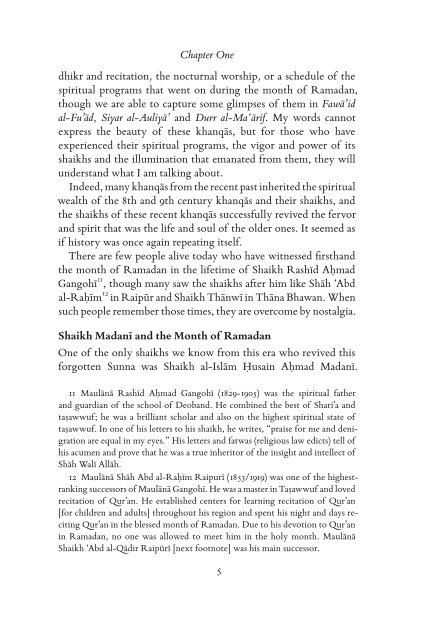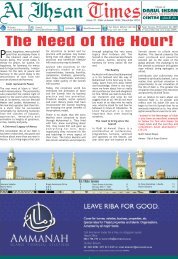TheRamadan of Shaykh Al-Hadith Ml ZakariyyaKandelwi by Dr Muhammad Ismail Memon Madani
TheRamadan of Shaykh Al-Hadith Ml ZakariyyaKandelwi by Dr Muhammad Ismail Memon Madani
TheRamadan of Shaykh Al-Hadith Ml ZakariyyaKandelwi by Dr Muhammad Ismail Memon Madani
Create successful ePaper yourself
Turn your PDF publications into a flip-book with our unique Google optimized e-Paper software.
Chapter One<br />
dhikr and recitation, the nocturnal worship, or a schedule <strong>of</strong> the<br />
spiritual programs that went on during the month <strong>of</strong> Ramadan,<br />
though we are able to capture some glimpses <strong>of</strong> them in Fawā’id<br />
al-Fu’ād, Siyar al-Auliyā’ and Durr al-Ma‘ārif. My words cannot<br />
express the beauty <strong>of</strong> these khanqās, but for those who have<br />
experienced their spiritual programs, the vigor and power <strong>of</strong> its<br />
shaikhs and the illumination that emanated from them, they will<br />
understand what I am talking about.<br />
Indeed, many khanqās from the recent past inherited the spiritual<br />
wealth <strong>of</strong> the 8th and 9th century khanqās and their shaikhs, and<br />
the shaikhs <strong>of</strong> these recent khanqās successfully revived the fervor<br />
and spirit that was the life and soul <strong>of</strong> the older ones. It seemed as<br />
if history was once again repeating itself.<br />
There are few people alive today who have witnessed firsthand<br />
the month <strong>of</strong> Ramadan in the lifetime <strong>of</strong> Shaikh Rashīd Aĥmad<br />
Gangohī 11 , though many saw the shaikhs after him like Shāh ‘Abd<br />
al-Raĥīm 12 in Raipūr and Shaikh Thānwī in Thāna Bhawan. When<br />
such people remember those times, they are overcome <strong>by</strong> nostalgia.<br />
Shaikh Madanī and the Month <strong>of</strong> Ramadan<br />
One <strong>of</strong> the only shaikhs we know from this era who revived this<br />
forgotten Sunna was Shaikh al-Islām Ĥusain Aĥmad Madanī.<br />
11 Maulānā Rashīd Aĥmad Gangohī (1829-1905) was the spiritual father<br />
and guardian <strong>of</strong> the school <strong>of</strong> Deoband. He combined the best <strong>of</strong> Shari’a and<br />
taśawwuf; he was a brilliant scholar and also on the highest spiritual state <strong>of</strong><br />
taśawwuf. In one <strong>of</strong> his letters to his shaikh, he writes, “praise for me and denigration<br />
are equal in my eyes.” His letters and fatwas (religious law edicts) tell <strong>of</strong><br />
his acumen and prove that he was a true inheritor <strong>of</strong> the insight and intellect <strong>of</strong><br />
Shāh Walī <strong>Al</strong>lāh.<br />
12 Maulānā Shāh Abd al-Raĥīm Raipurī (1853/1919) was one <strong>of</strong> the highestranking<br />
successors <strong>of</strong> Maulānā Gangohī. He was a master in Taśawwuf and loved<br />
recitation <strong>of</strong> Qur’an. He established centers for learning recitation <strong>of</strong> Qur’an<br />
[for children and adults] throughout his region and spent his night and days reciting<br />
Qur’an in the blessed month <strong>of</strong> Ramadan. Due to his devotion to Qur’an<br />
in Ramadan, no one was allowed to meet him in the holy month. Maulānā<br />
Shaikh ‘Abd al-Qādir Raipūrī [next footnote] was his main successor.<br />
5



